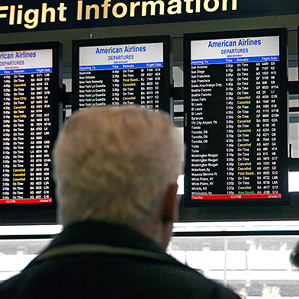A contest to improve flight arrival estimates is the first step in a plan to automate in-flight decisions.

Travelers are accustomed to long flight delays and cancellations for any host of reasons. Few realize that airlines themselves aren’t all that good at predicting when a flight will arrive at its destination even once it’s ready to leave the gate. Due to changes in weather, flight patterns, and bottlenecks, they are off by an average of seven minutes across the industry, says Gary Beck, vice president of flight operations for Alaska Airlines.
The winning algorithm—which produced flight arrival estimates that were nearly 40 percent better than current ones—could help airlines reduce gate congestion and manage crews more efficiently, and as a result could save travelers up to five minutes at the gate, say the prize sponsors. Each minute in reduction per flight could also save $1.2 million in annual crew costs and $5 million in annual fuel savings for a midsized airline.
The Flight Quest contest, set up on the data contest site Kaggle (see “Startup Turns Data Crunching Into a High-Stakes Sport”), provided entrants with a set of two months of flight data, such as arrivals, departures, weather, and latitudes and longitudes along the way, information typically not available to the public because it is owned by airlines and manufacturers, says GE vice president William Ruh.
The contest is the first step in GE’s plan to make air travel more efficient by building recommendation systems for pilots and dispatchers. It is also part of a larger initiative to offer real-time sensor data to customers who also buy its equipment (see “GE Pitches an Industrial Internet” and “What Is the Industrial Internet?”). GE is also announcing the results of a health-care data contest that is part of this effort.
Flights normally operate according to a flight plan put together a few hours in advance and tracked by a dispatcher, who may be monitoring 15 flights simultaneously. If, for example, headwinds pick up, a pilot would have to talk to a dispatcher, who may decide to reprogram the “cost index” for the flight, revise the flight plan, and give permission to the pilot to pick up speed (and burn more fuel) to get in on time.
Airlines have been looking to automate these kinds of processes to save costs and also give travelers a better flight. “We’ve got to get the human part of out of these communications, and get it down to a more automatic system,” says Beck, whose airline buys GE’s jet engines.
A second part of the Flight Quest contest—a $250,000 prize pool to be launched soon—will ask statisticians to suggest ways that airlines could use their data to actually adapt to changing circumstances during a flight. Eventually, GE plans to put the results of these contests into services and software, Ruh says. The goal wouldn’t be to replace pilot decisions, but to create smart assistants, he says.
It may, however, take a while before software can be used to fundamentally change how commercial flights are run.
Alaska Airlines, which frequently lands planes under difficult weather conditions, has pioneered the use of satellite navigation (as opposed to ground-based instruments) to lower the standard minimum elevations for a plane’s approach upon landing. It is now working with the U.S. Federal Aviation Administration to spread the technique, which also saves fuel, to the lower 48 states. Beck says the most difficult part has been changing the practices and official handbooks of air traffic controllers, who would no longer need to tell planes where to turn. “We’re basically changing their jobs from being controllers to being monitors,” he says.
No comments:
Post a Comment